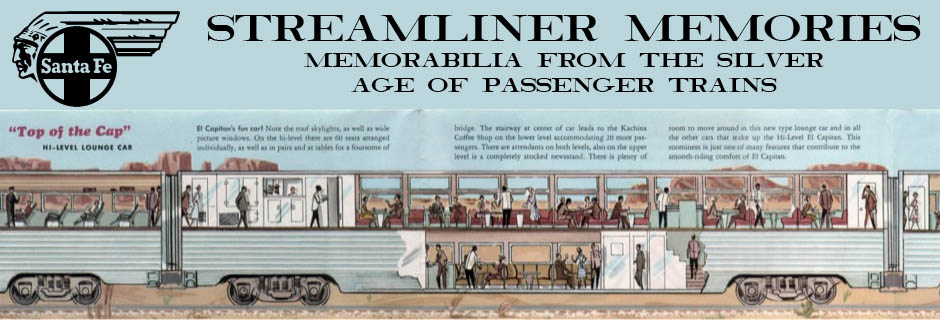Coming in a distant third after the streamlined Empire Builder and Olympian Hiawatha, the Northern Pacific’s streamlined North Coast Limited appeared in stages in 1948 when heavyweight cars were replaced by new streamlined cars as they were delivered by Pullman. Not only was the train later than its competitors, it was relatively uninspiring.

Click image to download a 5.2-MB PDF of this eight-page booklet.
For one thing, the Northern Pacific did not immediately speed up its premiere train to a 45-hour Chicago-Seattle schedule adopted by the Empire Builder and Olympian Hiawatha, instead leaving it at the older, 59-hour timetable until 1952. This put it at a huge disadvantage to both of its competitors.
Second, as a comparison of this brochure with the brochures for the Hiawatha and Empire Builder reveals, the streamlined North Coast Limited has the least amount of non-revenue space of the three Northwest trains. The lounge in the Empire Builder‘s observation car has 27 seats (eleven of which face the windows) compared with 25 (only three of which face windows) in the North Coast Limited.
The Olympian Hiawatha‘s observation lounge is a little smaller, with just 20 seats. But the Olympian Hiawatha has both a full diner, seating 40 people, and a full lounge-grill car, seating 42. The North Coast Limited combined its diner with a lunch counter, with a total of 42 seats. The coach-lounge car has only 14 seats in the lounge, with the rest of the car dedicated to 26 revenue coach seats.
The Builder had a 36-seat diner and a 20-seat lunch counter-lounge car that shared space with a crew dorm. In total, the Hiawatha had 102 non-revenue seats, while the Empire Builder had 83 and the North Coast Limited 81. The Northern Pacific did not add a full lounge car until 1955 or a full diner until 1958.
Here is how the Great Northern, Milwaukee Road, and Northern Pacific each portrayed their coffee shop/lounge cars. Which looks more attractive to you?
While the Empire Builder has only a slight edge on the Northern Pacific train, the Builder‘s non-revenue spaces were much more brightly decorated, with Hudson Bay-blanket colors in both lounges; Blackfoot tribal symbols and etched glass in the coach lounge; Charles Russell and Winold Reiss paintings in the observation lounge; and wildflower paintings in the diners. By comparison, with the exception of a print of Mt. Rainier and a couple of posters, the North Coast Limited‘s non-revenue spaces were almost completely devoid of decoration of any kind.
While providing the least non-revenue space, the Northern Pacific crammed more people into its cars than the other two railroads. For example, its “day-nite” coaches each had 56 seats, while the Olympian‘s had 52 and the Empire Builder’s had only 48, meaning they offered more leg room.
Altogether, the standard Empire Builder had 307 revenue seats to 83 non-revenue for a ratio of 3.7 to 1. The typical summer Olympian Hiawatha had 374 revenue seats, but with 102 non-revenue it also had a 3.7-to-1 ratio. The North Coast Limited typically carried 322 seats, for a ratio of 4.0 to 1.
Finally, though Northern Pacific advertising claimed the train was fully streamlined by the end of 1948, in fact it continued to include heavyweight baggage and sleeping cars for several more years. This is probably one of the reasons why it did not speed up the trains: the older cars might not have been able to handle the higher speeds and the Diesels probably had a harder time accelerating the train with the heavier consists.



